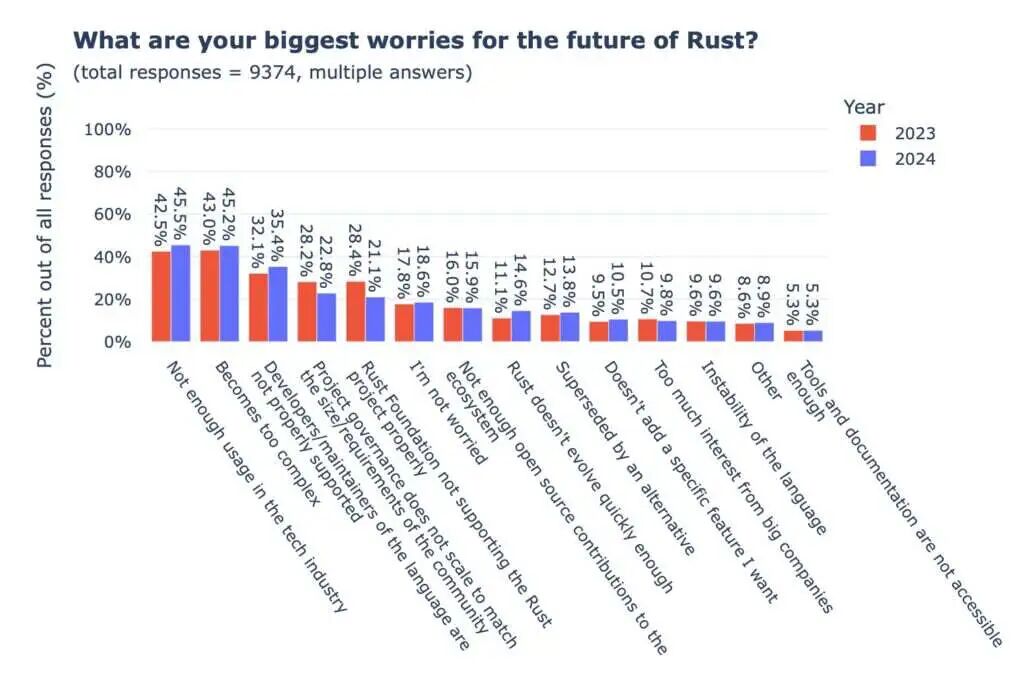Author | Tim Anderson
Translator | Sambodhi
Editor | Tina

The results of the 2024 Rust survey have been released, showing an increase in productivity, but slow compilation and debugging difficulties remain significant challenges. Another concerning issue is that, despite Rust’s safety advantages, its adoption rate has not grown as expected. Developers point out that low adoption and high complexity are reasons for their concerns about the future.
This survey specifically targets Rust developers, so it cannot be directly compared to the usage of Rust against other languages. However, we can find related data elsewhere, such as the Stack Overflow Developer Survey, which shows a slight decline in Rust’s usage rate, from 13.05% in 2023 to 12.6% in 2024.
Correspondingly, the number of developers participating in the latest “State of Rust” survey has also decreased, from 11,950 in 2023 to 9,450 in 2024, with the number of completed surveys dropping from 9,710 to 7,310. The Rust survey team attributes this to a shortened submission window: two weeks in 2024 compared to nearly a month in 2023. Although this is a factor, the data still indicates that despite recommendations from well-known organizations and companies, including the U.S. government and Microsoft, for security reasons to use Rust, its adoption rate has not significantly increased.
One possible reason is that Rust is overly complex and difficult to learn. In 2023, less than half (47%) of respondents felt they were efficient enough in Rust. This number has now increased to 53%, but it is still surprising that a considerable proportion of respondents are still in the experimental or learning phase.
 A major concern for Rust developers is the low adoption rate in the industry.
A major concern for Rust developers is the low adoption rate in the industry.
When asked about their biggest concern for the future of Rust, 45.5% of respondents indicated that it was “insufficient adoption in the tech industry,” an increase from 42.5% last year, followed closely by 45.2% of respondents worried about complexity. Other major concerns include insufficient support for Rust developers and maintainers, as well as project governance issues. Only 18.6% of respondents indicated “no concerns,” up from 17.8% in 2023.
While support for Rust in the Linux kernel could promote the language’s development, it has sparked controversy due to opposition from maintainers. These maintainers believe that kernel code should only use the C language, with Christoph Hellwig comparing the introduction of another language to cancer, stating that Rust should not appear in large C codebases that he maintains.
If patches to further integrate Rust with the kernel fail to gain approval, the future of the entire Rust for Linux project will be at risk.
Another question asked respondents whether they use Rust in their work. 38.2% of respondents indicated that most of their coding work is done in Rust, while 13.4% reported using it a few times a week, with the overall percentage slightly above half. At the organizational level, a similar trend is observed. 45.5% of respondents’ organizations “use Rust to some extent,” up from 38.7% last year. Although these numbers have increased since 2023, they still indicate that many respondents have not been able to widely apply Rust in their work.
Rust is suitable for systems programming, but according to the survey results, it is also popular in general applications. The largest usage category is server applications (53.4%), followed by distributed systems (25.3%) and cloud computing applications (24.3%).
Rust developers primarily use Linux (73.7%), and this proportion has been increasing year by year, continuing to rise since 2022. Next is macOS (32.4%) and Windows (29.8%), but among developers using Windows, 13.3% use WSL (Windows Subsystem for Linux).
Linux remains the most popular target platform for Rust applications (87.1%), although WebAssembly has also garnered significant attention, with 23% of developers using WebAssembly in browsers and 7.7% using it for other hosts. Since the last survey combined all WebAssembly usage, direct comparisons with previous years are not possible.
Visual Studio Code (VS Code) remains the most popular integrated development environment for Rust, with a usage rate of 56.7%, although its share has decreased by 5%. Despite the Rust-based Zed editor not being completed, its usage is also quite considerable, reaching 8.9%.
Original link
https://devclass.com/2025/02/18/state-of-rust-survey-2024-most-rust-developers-worry-about-the-future-of-the-language/
Article copyright belongs to InfoQ and may not be reproduced without permission.
Today’s Recommended ArticlesOpenAI “Agent Bible” Flops? LangChain Founder Angrily Responds “All Are Pits”! NVIDIA Halts Lepton AI Operations! Bans New User Registrations, Cancels Official Twitter, Jia Yangqing’s Startup Acquired, Two Years Later Returns to Big Tech as an Engineer Again Bearing the Blame for AI? Cursor’s Restrictions on Multi-Device Logins Anger Users, Competitors Seize the Opportunity to Snatch Users! Too Many New Pits, “Simply Ruining Mentality”! OpenAI Core Members Reveal the Two-Year Development Process of GPT-4.5: Constantly Responding to Challenges